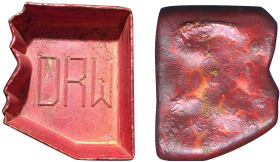The stapler has always held a fascination for me. It combines humble utility with a certain vague menace inherent to its function.
In elementary school I admired those teachers who had unlocked the secrets of the stapler. They were able to release the base so it hung loose like a broken jaw, in order to staple construction paper and artwork onto the bulletin board. The memory puts me in mind of those herpetologists who extract venom from poisonous snakes, handling a dangerous creature with easy confidence.
The precursors of the contemporary stapler were first patented during the late nineteenth century. Some early staplers only loaded one staple at a time. Others bent straight pins into staples. Still others cut individual staples from a spool of wire, which looped behind the mechanism like a tail. The familiar standard of loading pre-formed staples into a chamber become dominant around World War II.
Modern staplers are fairly homogeneous, of course. The bizarre early variants are now a part of history. Even so, some latter-day staplers demonstrate individuality and whimsy.
My interest in staplers was renewed when I came to own a vintage Ace 404 (above). For years I had made do with a miniature plastic Swingline model, a marginal tool at best. More than three or four sheets of paper and it was done for. Worse, if given a solid thwack it tended to flip over sideways and fall onto the floor. The 404, by contrast, is an exemplar of mid-century reliability. It chews through a hefty sheaf of paper without breaking a sweat, and its bell-shaped hand pump encourages the most aggressive pounding. I am happy to oblige.
My next acquisition was an Ace 502. The upper portion of this stapler is brown and black Bakelite. The design owes a lot to the Streamline Moderne aesthetic, which also informed the look of appliances and autos well into the post-war era.
Later, on a more pragmatic level, I decided I needed one of those really big industrial-strength staplers and bought a Swingline 415. This is a Mack truck of a tool, using (to extend the metaphor) giant steel-belted-radial-like staples. This one is prepared to staple up to 160 sheets at a time. Mostly it gathers dust in the garage, but I think of it as a sort of mechanical security blanket, standing ready for the most daunting stapling tasks.
When we envision what technology will look like far into the future, it is sometimes tempting to conceive of a world entirely transformed and unrecognizable. But I like to imagine that the stapler, steadfast and indispensable, will be with us for a long time to come.



